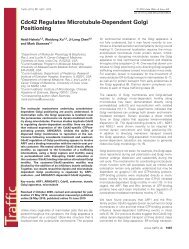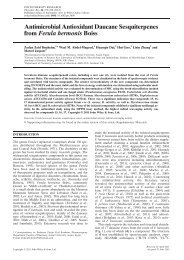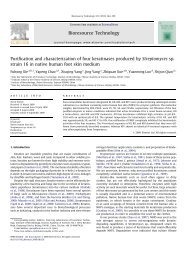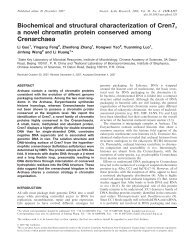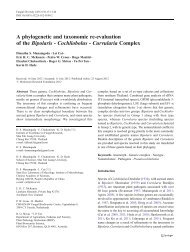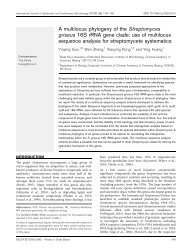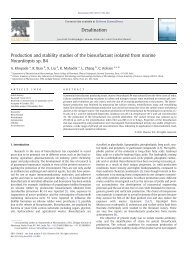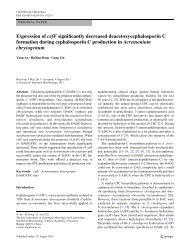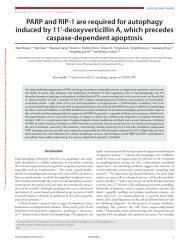A Novel Two-Stage Cultivation Method to Optimize Carbon ...
A Novel Two-Stage Cultivation Method to Optimize Carbon ...
A Novel Two-Stage Cultivation Method to Optimize Carbon ...
You also want an ePaper? Increase the reach of your titles
YUMPU automatically turns print PDFs into web optimized ePapers that Google loves.
Folia Microbiol. 54 (2), 142–146 (2009)<br />
http://www.biomed.cas.cz/mbu/folia/<br />
A <strong>Novel</strong> <strong>Two</strong>-<strong>Stage</strong> <strong>Cultivation</strong> <strong>Method</strong> <strong>to</strong> <strong>Optimize</strong><br />
<strong>Carbon</strong> Concentration and <strong>Carbon</strong>-<strong>to</strong>-Nitrogen Ratio<br />
for Sporulation of Biocontrol Fungi<br />
L. GAO a,b , X.Z. LIU a *<br />
a Key Labora<strong>to</strong>ry of Systematic Mycology and Lichenology, Institute of Microbiology, Chinese Academy of Sciences,<br />
Chaoyang District, Beijing 100 010, P.R. China<br />
fax +86 10 6480 7505<br />
e-mail liuxz@im.ac.cn<br />
b State Key Labora<strong>to</strong>ry for Biology of Plant Disease and Insect Pests, Institute of Plant Protection,<br />
Chinese Academy of Agricultural Sciences, Beijing 100 193, P.R. China<br />
Received 2 July 2008<br />
Revised version 1 December 2008<br />
ABSTRACT. A two-stage solid cultivation method was used <strong>to</strong> determine the precise requirements of carbon<br />
concentration (1–16 g/L) and C : N ratio (0.625 : 1 <strong>to</strong> 80 : 1) for the sporulation of six biocontrol fungi.<br />
The C concentration and C : N ratio producing the highest conidia yield were 1 g/L and 5 : 1 for Paecilomyces<br />
lilacinus IPC-P; 2 g/L and 10 : 1 for P. lilacinus M-14; 16 g/L and 80 : 1 for Metarhizium anisopliae<br />
SQZ-1-21; 4 g/L and 5 : 1 for M. anisopliae RS-4-1 and Lecanicillium lecanii CA-1-G; and 2 g/L and 10 : 1<br />
for Trichoderma viride TV-1. Sporulation was more affected by C : N ratio than by C and N concentration<br />
per se. More spores per colony were produced by the two-stage method than by a conventional, single-stage<br />
cultivation method. These results should be useful for improving the mass production of these biocontrol<br />
agents.<br />
Abbreviations<br />
CC continuous cultivation TC two-stage (solid) cultivation<br />
LSD least significant difference PDA pota<strong>to</strong> dextrose agar<br />
Lecanicillium lecanii, Metarhizium anisopliae, Paecilomyces lilacinus, and Trichoderma viride have<br />
been extensively studied as promising biocontrol agents (Ekbom 1979; Papavizas 1985; Mittal et al. 1995;<br />
Arthurs and Thomas 2001; Azaizeh et al. 2002; Sun and Liu 2006), and some have been commercialized<br />
(Liu and Li 2004). Their mass-production at present is largely dependent on a two-phase system (Feng et al.<br />
1994), i.e., mycelium growth in liquid medium and sporulation on solid substrate. Solid incubation for sporulation,<br />
however, generally requires a long fermentation period and a large space relative <strong>to</strong> the quantity of<br />
spores produced (Jenkins et al. 1998). In view of these problems, many studies have been carried out <strong>to</strong> increase<br />
production efficiency by optimizing nutritional requirements and other cultivation conditions for sporulation<br />
(Walker and Riley 1982; Mortensen 1988; Weidemann 1988; Jackson and Slininger 1993).<br />
The C concentration is an important fac<strong>to</strong>r affecting fungal sporulation (Elson et al. 1998; Gao et<br />
al. 2007); our previous studies have measured the effects of numerous C sources (and N sources, vitamins<br />
and minerals) on mycelial growth and sporulation of biocontrol fungi (Sun and Liu 2006; our unpublished<br />
data). A lower C concentration usually increases sporulation of filamen<strong>to</strong>us fungi, and several researches<br />
have demonstrated that sporulation could be enhanced by the exhaustion of the saccharide source for Aspergillus<br />
niger (Galbraith and Smith 1969) or by the depletion of the N source for Aspergillus nidulans (Carter<br />
and Bull 1969). Pycnidia also formed more frequently when nutrient concentration was low (Nebane and<br />
Ekpo 1992; Xiao and Sit<strong>to</strong>n 2004). The phosphate, C, and N levels in liquid media significantly influenced<br />
blas<strong>to</strong>spore production of Beauveria bassiana (Thomas et al. 1987; Hegedus et al. 1990; Bosch and Yan<strong>to</strong>rno<br />
1999). The finding that media with high C concentration are unfavorable for conidia production may<br />
explain why some fungi produce relatively few conidia on PDA, which provides ≈10 g of C per L (Jackson<br />
and Bothast 1990). In some cases, however, media with a high C and N concentration support good sporulation<br />
of fungi, e.g., a medium with 80 g of glucose per L and 13.2 g of casamino acids per L resulted in a high<br />
blas<strong>to</strong>spore yield of Paecilomyces fumosoroseus (Jackson and Bothast 1990; Jackson and Schisler 1992).<br />
*Corresponding author.
2009 NOVEL TWO-STAGE CULTIVATION METHOD FOR OPTIMIZING SPORULATION OF FUNGI 143<br />
The C : N ratio is another important fac<strong>to</strong>r affecting fungal sporulation (Elson et al. 1998; Gao et al.<br />
2007). Jackson and Bothast (1990) found that Colle<strong>to</strong>trichum truncatum produced more conidia in media<br />
with a C : N ratio of 15 : 1 than 40 : 1 or 5 : 1, and the biological control agent Talaromyces flavus produced<br />
more ascospores as the C : N ratio increased from 5 : 1 <strong>to</strong> 30 : 1 (Engelkes et al. 1997). However, higher<br />
C : N ratio or higher C concentration reduced sporulation of isolate HSND07 of Helminthosporium solani<br />
(Elson et al. 1998). However, Jackson et al. (1997) found that the blas<strong>to</strong>spore yields of P. fumosoroseus<br />
were insensitive <strong>to</strong> C : N ratio at 10 : 1, 30 : 1 or 40 : 1 at C concentration of 4 g/L. The optimal C : N ratio<br />
for sporulation depends on the fungal species and/or isolates.<br />
Traditionally, researchers used CC (continuous cultivation) on agar plates <strong>to</strong> investigate nutritional<br />
and other cultural requirements. With continuous growth on agar, however, the vegetative growth may<br />
deplete nutrients in the medium before sporulation takes place. Thus, the exact nutritional requirements for<br />
sporulation are unknown. To better understand how nutrition affects sporulation, we applied here a TC (twostage<br />
cultivation) method (Sun et al. 2009). In the first stage, fungi are grown for 4 d on an agar medium<br />
with a defined nutrient content. To induce sporulation, the colonies are then transferred <strong>to</strong> a second agar medium<br />
containing a wider range of known C concentration and C : N ratio.<br />
MATERIALS AND METHODS<br />
Fungi. Six isolates included three nema<strong>to</strong>phages (P. lilacinus M-14, P. lilacinus IPC-P, M. anisopliae<br />
SQZ-1-21), two en<strong>to</strong>mopathogens (M. anisopliae RS-4-1, L. lecanii CA-1-G), and a mycoparasite (Trichoderma<br />
viride TV-1). All fungi were deposited in the Center of General Microorganisms Culture Collection<br />
in the Institute of Microbiology, Chinese Academy of Sciences (Table I).<br />
Table I. Details of fungal isolates used<br />
Species<br />
Isolate<br />
Deposition<br />
no. CGMCC<br />
Host Location Isolated by<br />
Paecilomyces lilacinus IPC-P 3.10031 Meloidogyne incognita Lima, Peru P. Jatala<br />
P. lilacinus M-14 3.10032 Heterodera glycines Huanan County, Heilongjiang, China X.Z. Liu<br />
Metarhizium anisopliae SQZ-1-21 3.10033 Meloidogyne arenaria Qingzhou, Shandong, China M.H. Sun<br />
M. anisopliae RS-4-1 3.10035 soil a Jiangsu, China Z.A. Chen<br />
Lecaticillium lecanii CA-1-G 3.10036 Myzus persicae Fujian, China M. Xie<br />
Trichoderma viride TV-1 3.10038 Alternaria alternata Yunnan, China G. Wang<br />
a With Galleria mellonella baiting.<br />
For preparing homogeneous spore suspensions, each fungus was cultured on PDA (Oxoid, UK) plates<br />
at room temperature for 2 weeks. <strong>Two</strong> plugs ( 5.0 mm) of each isolate growing on PDA plates were<br />
transferred <strong>to</strong> 10 mL of sterile 500 ppm Tween 80 in a 50-mL centrifuge tube, and conidia were then suspended<br />
with a WH-861 vortex shaker (Koled, China). Conidia number was determined with a hemocy<strong>to</strong>meter<br />
and adjusted <strong>to</strong> 5 × 10 4 conidia per mL (Elson et al. 1998).<br />
Medium. One L of the basal medium contained 19 g of sucrose (equal <strong>to</strong> 8 g of C), 17 g of Bac<strong>to</strong><br />
(Difco) agar, 4 g of soy pep<strong>to</strong>ne (equal <strong>to</strong> 330 mg of N), 1 g of K 2 HPO 4 , 500 mg of KCl, 500 mg of MgSO 4 ,<br />
and 10 mg of FeSO 4 . C concentrations were adjusted with sucrose (42 % C) <strong>to</strong> 1, 2, 4, 8, and 16 g/L; N concentrations<br />
were adjusted with soy pep<strong>to</strong>ne (8 % N) <strong>to</strong> 0.2, 0.4, 0.8, and 1.6 g/L. The combinations of C and<br />
N concentrations resulted in C : N ratio ranging from 0.625 : 1 <strong>to</strong> 80 : 1.<br />
Determination of optimal carbon concentration and C : N ratio for sporulation. Sterile basal medium<br />
(15 mL) was poured in<strong>to</strong> plastic plates ( 90 mm; Miniplast, Israel). After agar solidified and 2 d before<br />
inoculation, a sterile cellophane membrane disc was placed on the surface of the agar in each plate; the disks<br />
90 mm for plates <strong>to</strong> be inoculated with T. viride and 35 mm for plates with the other fungi. A conidia<br />
suspension (5 L at ≈5 × 10 4 conidia per mL) was transferred on<strong>to</strong> the center of the sterile cellophane disk,<br />
and the plate was then sealed with double Parafilm (Pechiney Plastic Packaging, USA). After 4 d at 25 °C,<br />
the cellophane disks and associated colonies were transferred <strong>to</strong> fresh media with different C concentrations<br />
and C : N ratios, and cultured for further 4 d for sporulation. CC for 8 d on the basal medium with the cellophane<br />
disk was used as control. To quantify sporulation, both the colony and the disk were transferred in<strong>to</strong><br />
a 50-mL centrifuge tube containing 10 mL of 500 ppm Tween 80; spores were counted with a hemocy<strong>to</strong>meter.<br />
Triplication for each medium and each isolate were used in both TC and CC method.
144 L. GAO and X.Z. LIU Vol. 54<br />
Statistical analysis. Sporulation data (number of conidia per colony) were transformed logarithmically<br />
before statistical analysis with Statistical Analysis System software (Version 8.2, SAS Institute, USA).<br />
Data were subjected <strong>to</strong> one-way analysis of variances (ANOVA), and means were separated using Fisher’s<br />
protected LSD or Duncan’s multiple-range test.<br />
RESULTS<br />
C concentration significantly affected the spore production of five of the six fungi, while N concentration<br />
significantly affected the spore production of three fungi (Table II). The effect of C : N ratio was extremely<br />
significant on the sporulation of all fungi, which indicated that we cannot predict the sporulation<br />
effect of C independently of N and vice versa. Generally, most sporulation occurred at lower C concentration<br />
and lower C : N ratio, but abundant sporulation sometimes occurred with higher C concentration and<br />
higher C : N ratio (Table III).<br />
Table II. Effects of carbon (C) and nitrogen (N) concentrations, and their combination (C × N) on sporulation of biocontrol<br />
fungi*<br />
Concentration<br />
g/L<br />
P. lilacinus M. anisopliae L. lecanii T. viride<br />
IPC-P M-14 SQZ-1-21 RS-4-1 CA-1-G TV-1<br />
C a a b a b ns<br />
N ns a ns a ns c<br />
C × N c c c c c c<br />
*a, b, c represent p < 0.05, p < 0.01, and p < 0.001, respectively; ns – no significant difference at p ≥ 0.05.<br />
<strong>Two</strong> isolates of the nema<strong>to</strong>phage P. lilacinus required different C concentration and C : N ratio for<br />
good sporulation. For IPC-P, C at 1 and 2 g/L with higher C : N ratio, and at 4 and 8 g/L with lower C : N<br />
ratio, supported abundant sporulation (Table III). IPC-P sporulation was significantly inhibited at the highest<br />
C concentration (16 g/L) with all C : N ratios, and the CC on the basal medium (control plates) led <strong>to</strong> low<br />
spore production. For M-14, C at 2 g/L with all C : N ratios supported abundant sporulation, and the highest<br />
conidial yield was obtained with C at 2 g/L with a C : N of 10 : 1. The highest C concentration (16 g/L) with<br />
the highest C : N ratio (80 : 1) also supported abundant sporulation (Table III). All treatments with the TC<br />
(except for C at 8 g/L with a C : N ratio of 20 : 1) resulted in significantly higher spore yield than the control<br />
(CC on the basal medium).<br />
For M. anisopliae SQZ-1-21, lower C concentrations at 1 and 4 g/L with lower C : N ratios supported<br />
abundant sporulation but spore production was highest at C of 16 g/L with a C : N ratio of 80 : 1<br />
(Table III). All C : N ratios at C of 8 g/L inhibited sporulation. For M. anisopliae RS-4-1, higher C concentrations<br />
at 8 and 16 g/L with all C : N ratios (except 8 g/L with a C : N of 20 : 1) inhibited sporulation, and<br />
lower C concentrations with lower C : N ratios increased sporulation. Spore yield for M. anisopliae RS-4-1<br />
was highest at 4 g/L of C with a C : N of 5 : 1, followed by 2 g/L with a C : N of 1.25 : 1, and 1 g/L with<br />
a C : N of 0.625 : 1. All other treatments (except C at 16 g/L with a C : N of 10 : 1) supported higher M. anisopliae<br />
RS-4-1 spore yields than did the control.<br />
The responses of the en<strong>to</strong>mopathogen L. lecanii CA-1-G <strong>to</strong> C concentration and C : N ratio were<br />
similar <strong>to</strong> those of the other fungi, but the differences between treatments were less (Table III). More spores<br />
were produced at lower C concentrations with lower C : N ratios and at higher C ones with higher C : N<br />
ones. Sporulation of L. lecanii CA-1-G was poor with 8 g/L of C regardless of C : N ratio.<br />
For the mycoparasite T. viride TV-1, the spore yield was highest with 2 g/L of C and a C : N of<br />
10 : 1, followed by 1 g/L and a C : N of 5 : 1 and 8 g/L with a C : N of 20 : 1. All the C : N ratios at 16 g/L<br />
of C greatly inhibited sporulation (Table III).<br />
DISCUSSION<br />
TC provides a new method <strong>to</strong> determine the nutritional requirements for fungal sporulation. Our results<br />
indicated that TC resulted in much greater spore yields than CC. Relative <strong>to</strong> CC, TC increased maxi-
2009 NOVEL TWO-STAGE CULTIVATION METHOD FOR OPTIMIZING SPORULATION OF FUNGI 145<br />
mum spore yields 3× for P. lilacinus IPC-P, M. anisopliae SQZ-1-21, L. lecanii CA-1-G, and T. viride TV-1;<br />
19× for P. lilacinus M-14, and 27× for M. anisopliae RS-4-1.<br />
Table III. Effect of carbon concentration (g/L) and C : N ratio on the sporulation of biocontrol agents by two-stage cultivation method<br />
(10 6 conidia per colony)*<br />
<strong>Carbon</strong><br />
C : N<br />
P. lilacinus M. anisopliae L. lecanii T. viride<br />
IPC-P M-14 SQZ-1-21 RS-4-1 CA-1-G TV-1<br />
1 5 28.9 a 167. j 55.5 fg 291. eghi 337. j 286.0 b<br />
1 2.5 22.9 b 107. n 194. c 359. def 269. k 108.9 f<br />
1 1.25 6.8 fgh 117. m 195. c 386. de 225. l 210.0 c<br />
1 0.625 8.5 ef 185. h 126. e 642. bc 438. ef 59.9 g<br />
2 10 24.7 b 630. a 189. c 186. fghijkl 438. ef 451.7 a<br />
2 5 24.3 b 443. c 147. de 252. efghi 612. c 17.0 h<br />
2 2.5 5.2 hi 466. b 32.9 gh 344. defgh 860. b 167.7 de<br />
2 1.25 3.4 ij 201. g 159. d 712. b 34.8 o 6.7 h<br />
4 20 3.0 jk 173. i 65.3 f 204. efghijkl 415. fg 185.7 cd<br />
4 10 3.2 j 215. f 131. e 358. defg 122. n 56.5 g<br />
4 5 16.7 c 163. j 194. c 1540. a 983. a 2.8 h<br />
4 3 24.7 b 231. e 247. b 246. efghij 419. efg 14.5 h<br />
8 40 9.3 e 111. n 43.7 fg 161. hijkl 170. m 5.9 h<br />
8 20 8.5 ef 35.8 p 67.3 f 512. cd 172. m 270.7 b<br />
8 10 17.2 c 123. l 53.2 fg 64.2. jkl 161. m 5.3 h<br />
8 5 11.5 d 118. m 56.3 fg 164. hijkl 343. j 2.0 h<br />
16 80 1.2 k 315. d 801. a 228. efghijk 439. e 6.5 h<br />
16 40 8.3 efg 154. k 47.3 fg 171. hijkl 582. d 1.9 h<br />
16 20 6.5 gh 84.0 o 18.3 h 109. ijkl 402. gh 0.8 h<br />
16 10 6.7 fgh 116. m 39.9 gh 20.8 l 386. hi 1.2 h<br />
8** 24 8.5 ef 34.0 p 242. b 56.4 kl 377. i 134.6 e<br />
LSD 2.0 5.1 24.0 187. 23.9 29.0<br />
*Means of triplicates; values in the same column followed by the same letter are not significantly different (LSD; p < 0.05).<br />
**Control.<br />
Although sporulation varied here in response <strong>to</strong> the C and N concentrations, it was always very sensitive<br />
<strong>to</strong> C : N ratio (Table II). The concentration of C had more effect on sporulation than that of N, in that<br />
five of six tested fungi were sensitive <strong>to</strong> C concentration, while only three were sensitive <strong>to</strong> N concentration.<br />
Although higher spore yields sometimes occurred with higher C concentration along with higher C : N ratios,<br />
the highest sporulation generally occurred at lower C concentration with lower C : N ratios.<br />
We used a wider range of C concentration and lower one (1–16 g/L) than previous papers (Evans and<br />
Black 1981; Jackson and Bothast 1990; Elson et al. 1998). For the maximum spore production of fungi with<br />
lower costs, C concentration was set up as low as 1 g/L which is lower than any previous related researches,<br />
such as 6 g/L in Evans and Black (1981) medium, 2 g/L in Jackson and Bothast (1990) medium and 1.25 g/L<br />
in Elson et al. (1998) medium. A wider range of C concentration resulted in a wider range of C : N ratio<br />
(from 0.625 : 1 <strong>to</strong> 80 : 1), which allowed us <strong>to</strong> obtain more details about the nutritional requirements for sporulation.<br />
We were interested in reducing costs for spore production and therefore in finding the minimal C requirement.<br />
Substrates that support the highest production of spores do not necessarily result in their highest<br />
quality. For example, although a medium with a C : N of 30 : 1 produced the greatest number of conidia of<br />
C. truncatum (a biocontrol fungus against weeds), a medium with a C : N of 10 : 1 produced conidia that<br />
were most effective against the weed Sesbania exaltata (Schisler et al. 1991); the C : N ratio influenced the<br />
lipid content of C. truncatum spores, and lipid content regulates appressorium formation (Jackson and Schisler<br />
1992). C concentration and C : N ratio can also affect shelf-life and survival after application, e.g., conidia<br />
of C. truncatum produced in media with excess C vs. N would often accumulate and s<strong>to</strong>re trehalose (Jackson<br />
and Bothast 1990; Jackson and Schisler 1995), which has been associated with desiccation <strong>to</strong>lerance (Costa<br />
et al. 2000). Zhang et al. (2005) found that Cryp<strong>to</strong>coccus nodaensis OH 182.9 produced more freeze-<strong>to</strong>lerant<br />
cells on media with higher C : N ratio.
146 L. GAO and X.Z. LIU Vol. 54<br />
This project was jointly supported by the National Hi-Tech Program of China (no. 2006–AA10 A211), the Knowledge<br />
Innovation Program of the Chinese Academy of Sciences (KSCX2-YW-G-037) and National Natural Scientific Foundation of China<br />
(no. 3077 0072 and 3062 5001). The authors also thank Prof. B. Jaffee (University of California at Davis) for serving as pre-submission<br />
reviewers and for his valuable comments and suggestions.<br />
REFERENCES<br />
ARTHURS S., THOMAS M.B.: Effects of dose, pre-mortem host incubation temperature and thermal behavior on host mortality, mycosis<br />
and sporulation of Metarhizium anisopliae var. acridum in Schis<strong>to</strong>cerca gregaria. Biocontrol Sci.Techn. 11, 411–420 (2001).<br />
AZAIZEH H., GINDIN G., SAID O., BARASH I.: Biological control of the western flower thrips Frankliniella occidentalis in cucumber<br />
using the en<strong>to</strong>mopathogenic fungus Metarhizium anisopliae. Phy<strong>to</strong>parasitica 30, 18–24 (2002).<br />
BOSCH A., YANTORNO O.: Microcycle conidiation in the en<strong>to</strong>mopathogenic fungus Beauveria bassiana (BALS.) VUILL. Process Biochem.<br />
34, 707–716 (1999).<br />
CARTER B.L., BULL A.T.: Studies of fungal growth and intermediate carbon metabolism under steady state and non-steady conditions.<br />
Biotechnol.Bioeng. 11, 785–804(1969).<br />
COSTA E., USALL J., TEIXIDÓ N., GARCIA N., VIÑAS I.: Effect of protective agents, rehydration media and initial cell concentration on<br />
viability of Pan<strong>to</strong>ea agglomerans strain CPA-2 subjected <strong>to</strong> freeze-drying. J.Appl.Microbiol. 89, 793–800 (2000).<br />
EKBOM B.S.: Investigations on the potential of a parasitic fungus (Verticillium lecanii) for the biological control of the greenhouse<br />
whitefly (Trialeurodes vaporarium). Swed.J.Agric.Res. 9, 129–138 (1979).<br />
ELSON M.K., SCHISLER D.A., JACKSON M.A.: <strong>Carbon</strong>-<strong>to</strong>-nitrogen ratio, carbon concentration, and amino acid composition of growth<br />
media influence conidiation of Helminthosposition solani. Mycologia 98, 406–413 (1998).<br />
ENGELKES C.A., NUCLO R.L., FRAVEL D.R.: Effect of carbon, nitrogen, and carbon-<strong>to</strong>-nitrogen ratio on growth, sporulation and biocontrol<br />
efficacy of Talaromyces flavus. Phy<strong>to</strong>pathology 87, 500–505 (1997).<br />
EVANS R.C., BLACK C.L.: Interaction between nitrogen sources and xylose affecting growth, conidiation, and polyphenoloxidase activity<br />
in Bipolaris maydis race T. Can.J.Bot. 59, 2102–2107 (1981).<br />
FENG M.G., POPRAWSKI T.J., KHACHATOURIANS G.G.: Technology for production, formulation and application of the en<strong>to</strong>mopathogenic<br />
fungus Beauveria bassiana for insect control: current status worldwide. Biocontrol Sci.Techn. 4, 3–34 (1994).<br />
FRANCO J., JATALA P., BOCANGEL M.: Efficiency of Paecilomyces lilacinus as a biological agent of Globodera pallida. J.Nema<strong>to</strong>l. 13,<br />
438–439 (1981).<br />
GALBRAITH J.C., SMITH J.E.: Sporulation of Aspergillus niger in submerged liquid culture. J.Gen.Microbiol. 59, 31–45 (1969).<br />
GAO L., SUN M.H., LIU X.Z., CHE Y.S.: Effects of carbon concentration and carbon <strong>to</strong> nitrogen ratio on the growth and sporulation<br />
of several biological control fungi. Mycol.Res. 111, 87–92 (2007).<br />
HEGEDUS D.D., BIDOCHKA M.J., KHACHATOURIANS G.G.: Beauveria bassiana submerged conidia production in a defined medium<br />
containing chitin, two hexosamines or glucose. Appl.Microbiol.Biol. 33, 641–647 (1990).<br />
JACKSON M.A., BOTHAST R.J.: <strong>Carbon</strong> concentration and carbon <strong>to</strong> nitrogen ratio influence submerged culture conidiation by the<br />
potential bioherbicide Colle<strong>to</strong>trichum truncatum NRRL 13737. Appl.Environ.Microb. 56, 3435–3438 (1990).<br />
JACKSON M.A., SCHISLER D.A.: The composition and attributes of Colle<strong>to</strong>trichum truncatum spores are altered by the nutritional<br />
environment. Appl.Environ.Microb. 58, 2260–2265 (1992).<br />
JACKSON M.A., SCHISLER D.A.: Liquid culture production of microsclerotia of Colle<strong>to</strong>trichum truncatum for use as bioherbicidal propagules.<br />
Mycol.Res. 99, 879–884 (1995).<br />
JACKSON M.A., SLININGER P.J.: Submerged culture conidial germination and conidiation of the bioherbicide Colle<strong>to</strong>trichum truncatum<br />
are influenced by the amino acid composition of the medium. J.Ind.Microbiol. 12, 417–422 (1993).<br />
JACKSON M.A., MCGUIRE M.R., LACEY L.A.: Liquid culture production of desiccation <strong>to</strong>lerant blas<strong>to</strong>spores of the bioinsecticidal fungus<br />
Paecilomyces fumosoroseus. Mycol.Res. 101, 35–41 (1997).<br />
JENKINS N.E., HEVIEFO G., LANGEWALD J., CHERRY A.J., LOMER C.J.: Development of mass production technology for aerial conidia<br />
for use as mycopesticides. Biocontrol News Inform. 19, 21–31 (1998).<br />
LIU X.Z., LI S.D.: Fungi secondary metabolites in biological control of crop pests, pp. 723–744 in Z.Q. An (Ed.): Handbook of Industrial<br />
Mycology. Marcel Dekker, New York 2004.<br />
MITTAL N., SAXENA G., MUKERJI K.G.: Integrated control of root-knot disease in three crop plants using chitin and Paecilomyces lilacinus.<br />
Crop Protect. 14, 647–651 (1995).<br />
MORTENSEN K.: The potential of an endemic fungus, Colle<strong>to</strong>trichum gloeosporioides, for biologiacal control of round-leaved mallow<br />
(Malva pusilla) and velvet leaf (Abutilon theophrasti). Weed Sci. 36, 473–478 (1988).<br />
NEBANE C.L.N., EKPO E.J.A.: Effect of culture media, temperature and light on radial growth and pycnidium production of cowpea isolates<br />
of Phoma bakeriana. Ann.Appl.Biol. 121, 537–544 (1992).<br />
PAPAVIZAS G.C.: Trichoderma and Gliocladium: biology, ecology, and potential for biocontrol. Ann.Rev.Phy<strong>to</strong>pathol. 23, 23–54 (1985).<br />
SCHISLER D.A., JACKSON M.A., BOTHAST R.J.: Influence of nutrition during conidiation of Colle<strong>to</strong>trichum truncatum on conidial germination<br />
and efficacy in inciting disease on Sesbania exaltata. Phy<strong>to</strong>pathology 81, 587–590 (1991).<br />
SUN M.H., LIU X.Z.: <strong>Carbon</strong> requirements of some nema<strong>to</strong>phagous, en<strong>to</strong>mopathogenic and mycoparasitic hyphomycetes as fungal biocontrol<br />
agents. Mycopathologia 161, 295–305 (2006).<br />
SUN M.H., GAO L., LIU X.Z., WANG J.L.: Fungal sporulation in two-stage cultivation. Mycosystema 28, 64–72 (2009).<br />
THOMAS K.C., KHACHATOURIANS G.G., INGLEDEW W.M.: Production and properties of Beauveria bassiana conidia cultivated in submerged<br />
culture. Can.J.Microbiol. 33, 12–20 (1987).<br />
WALKER H.L., RILEY J.A.: Evaluation of Alternaria cassiae for the biocontrol of sicklepod (Cassia obtusifolia). Weed Sci. 30, 651–654<br />
(1982).<br />
WEIDEMANN G.J.: Effects of nutritional amendments on conidial production of Fusarium solani f.sp. cucurbitae on sodium alginate granules<br />
and on control of Texas gourd. Plant Dis. 72, 757–759 (1988).<br />
XIAO C.L., SITTON J.W.: Effects of culture media and environmental fac<strong>to</strong>rs on mycelial growth and pycnidial production of Potebniamyces<br />
pyri. Mycol.Res. 108, 926–932 (2004).<br />
ZHANG S.A., SCHISLER D.A., BOEHM M.J., SLININGER P.J.: <strong>Carbon</strong>-<strong>to</strong>-nitrogen ratio and carbon loading of production media influence<br />
freeze-drying survival and biocontrol efficacy of Cryp<strong>to</strong>coccus nodaensis OH 182.9. Phy<strong>to</strong>pathology 95, 626–631 (2005).





